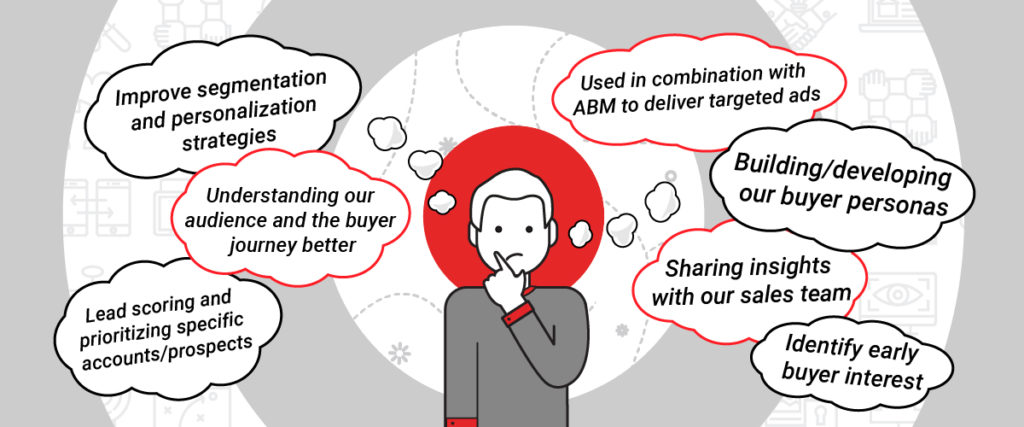By now, businesses are well aware that the better they know their prospects, the more likely they are to encourage conversion. Similarly, the better they understand their customers, the easier it is to retain them.
But when it comes to looking at data, it’s vital to learn more than just who your buyers are and where they are from. According to our latest research, 99% of B2B marketers are now using intent data to some extent, in order to find out what motivates their audience, what topics or subjects they are researching, what their journey looks like, and when they will be ready to convert.
But intent data is not one singular ‘insight’ – intent data is an umbrella term to describe a whole range of signals that can be gathered from different behavioral actions from an individual. Dependent on source, analysis and the action itself, intent data can be used in multiple different ways to help support greater overall marketing objectives.
With so many organizations now using intent data, we wanted to know – what objectives have they set in place when leveraging intent data? Do these objectives align with the benefits marketers have seen?

To build and develop accurate personas for B2B marketing
One of the most frequently-referenced reasons for using intent data in demand generation is creating and developing effective buyer personas, according to the 200 senior marketers we surveyed. This ranked in a similar position to content personalization, proving the power of intent for knowing more about B2B decision makers.
While in the past, creating a buyer persona was based solely on market research and educated speculation, today it’s a much more precise process. By harnessing intent data, marketers can confirm:
- Who their buyer personas are, based on the demographic, geographic and firmographic context of their audience
- That these individuals align with the type of content that they are creating
- That they are targeting and engaging their ideal personas
With this in mind, marketers are able to ensure that their target buyer personas and their actual buyer personas are one and the same, and that their messaging appeals to this audience. This is why a similar significant objective is to…
To improve segmentation and personalization strategies
Being able to understand exactly what makes your audience tick, and the topics they are researching, is a substantial benefit of intent data. This can be tracked using first party data as well as third party data.
The idea of collecting this data is to use it to your advantage when building your content strategy and email nurture workflows. While buyers don’t lack content options (and are in fact swamped by it at times), they do lack the patience to sift through different blogs and articles. Personalizing content for their needs will put your brand at the forefront, cutting through the noise and providing true value to the user.
The same can be said about engaging them via email marketing. Intent data can enable you to personalize and segment your content via workflows, ensuring you effectively nurture your audience and they receive consistently relevant content, resulting in a greater likelihood of engagement.
Our recent research highlights that 24% of B2B marketers use intent data with this purpose in mind. Despite this statistic seeming relatively low, 62% of B2B marketers later reported that ‘improved personalization and nurture workflows’ was a key benefit when using intent data. This suggests that although this was not the original intention when harnessing insights, it has been used in this way and has supported the customer journey.
The key to using intent signals to steer your content plan is to achieve relevant, useful, problem-solving content that is also well-timed in the purchasing journey.
To be able to score leads and prioritize specific accounts
According to our latest research, 56% of B2B marketers leverage intent data with the intention of lead scoring and being able to prioritize specific accounts. With so many communication channels and ways of distributing content, it can be a challenge to keep track of how many engagements a specific individual has had with your brand, as well as what their pain points are.
Lead scoring reduces the issue by enabling you to simply track engagement and further prioritize accounts based on the ‘lead score’ of the individual. The score builds based on two central factors:
- How many times they have engaged with content
- What type of content they have engaged with (Requesting a whitepaper vs. Reading an article or visiting a webpage
As a result, if an individual has a higher score compared to other prospects/customers, they have either engaged with more content, or they have engaged with content of higher value.
Having this information enables Marketing and Sales to better understand which individuals are most ‘in-market’ and therefore more likely to convert at that moment in time, and therefore prioritize them within their lead follow-up.
Despite this being a central objective for many marketers, many struggle to actually utilize intent data in this way, with only 42% confirming ‘Prioritizing lead follow-up’ to be a benefit of leveraging intent data. By working with third-parties to undertake lead scoring for you, marketers can better harness the value of intent data for lead scoring and account prioritization.
To share insights with our Sales Team
The data garnered from intent signal tracking isn’t just valuable to marketing teams either. To get the most out of your data, it should be shared with your sales team to ensure a united messaging and communication across all channels.
Indeed, 56% of B2B marketers today use intent data to gather further information about prospects and customers, to feed back to the Sales team.
By knowing when to call, and having an insight into their current pain points, sales teams can build trust with prospects, nurture them through the funnel, and improve relationships. The prospect is more likely to convert, due to feeling as though the Sales team have really understood their problems and provided a solution. Similarly, customers receive a better customer experience, allowing you to drive sales growth, increase loyalty and retention, and boost your brand reputation within your market.
To ensure we can harness early buyer interest
57% of individuals who harness intent data do so with the objective to better identify early buyer interest. Until the point that a prospect converts, by downloading a whitepaper or requesting contact through a contact form, marketers might have little-to-no visibility of any early buyer interest.
However, intent signals – such as ‘browsing’ or ‘action’ – highlights to an organization where there is interest in specific topics or when an individual has a certain pain point, before they take the action of converting. Third-party sources can assist best with this objective, by being able to identify new accounts who your organization are not yet aware of. This enables your Marketing team to adapt messaging and targeting to better reach and connect with new individuals, as well as highting fresh prospects to your Sales team.
To use in combination with ABM to deliver targeted ads
Finally, 51% of B2B marketers plan to utilize intent in combination with account-based marketing (ABM) strategies to deliver targeted ads. By finding new prospects early in their buyer journey, as well as building more accurate buyer personas, marketers can build an established target account list (TAL) based on actual accounts who are engaging, and ‘lookalike’ accounts based on firmographic and demographic information of current engagers.
Once the target-account list has been created, marketers can leverage their list of accounts in multiple advertising platforms, enabling them to get their most relevant/engaging content in front of specific audiences. It can be assumed that these accounts are more likely to engage than the general buyer persona audience, on the basis that some specific individuals from their organization have already shown intent, or that their firmographic information was similar to accounts that were already engaging.
This article first appeared in www.inboxinsight.com




